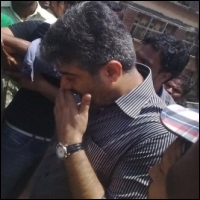Sanaa (Yemen) : Tribesmen loyal to Yemen’s embattled president on Tuesday clashed with a group of soldiers whose commander has sided with the opposition, and the fighting in a suburb of the capital Sanaa left three tribesmen dead, according to tribal elders and military officials.
It was the latest violence in weeks of turmoil in Yemen, where President Ali Abdullah Saleh’s military and police forces have cracked down on protesters demanding he step down after 32 years in power.
The clash erupted as a convoy of about 30 cars with armed tribesmen from Saleh’s Sanhan tribe arrived at the headquarters of the 1st Armored Division in western Sanaa to meet with its commander, Maj. Gen. Ali Mohsen al-Ahmar, who had earlier joined the opposition.
Tribal members and army officers at the scene said al-Ahmar, who also hails from Saleh’s tribe, met a tribal chief, Ismail Abu Hurriya, who tried to persuade the renegade commander to return to the president’s camp.
It was unclear how exactly the shooting started at the gate of the army compound. Several tribesmen were also wounded by the gunfire, witnesses said. Some said a group of government supporters appeared at the scene and opened fire, but conflicting reports could not be immediately clarified.
Security officials said the visit was an attempt by Saleh to mediate with al-Ahmar. All the witnesses and officials spoke on condition of anonymity because of the tense situation.
Earlier Tuesday, Saleh’s office said in a statement that the president had met with some leaders of his tribe to discuss the tensions.
The powerful Sanhan tribe is split between those remaining loyal to Saleh and those who have crossed over to the opposition. The tribe is also affiliated with the Hashid, the country’s biggest and most powerful tribe, which has sided with the opposition.
Al-Ahmar’s troops have stationed themselves close to the central square near Sanaa University to protect thousands of anti-Saleh protesters who have been camping for weeks, refusing to give up their protest until Saleh leaves office.
Yemen’s opposition parties urged the international community, regional powers and human rights groups to help stop the bloodshed in the country. More than 120 people have been killed and 5,000 injured since Yemen’s protests started in Feb. 11, inspired by the popular uprisings in Tunisia and Egypt.
The parties issued a statement late Monday accusing Saleh, his sons and relatives, as well as security and military apparatuses they control of carrying out planned attacks against peaceful demonstrations with the intent to kill.
EU foreign policy chief Catherine Ashton expressed grave concern for “the reports of violent repression, including live ammunition, against demonstrators.” In a statement Tuesday, she said she contacted Saleh last week to call for an orderly handover. “Transition must begin now,” she said in the statement.
Saleh has clung to power, saying Yemen will sink into chaos if he goes, warning of growing al-Qaida influence.
In Taiz, dozens of protesters were treated from breathing problems after police fired tear gas as thousands of demonstrators took to the streets for a third straight day to press for Saleh’s ouster.
On Monday, at least 15 people were killed when military forces and police snipers opened fire on demonstrators who marched past the governor’s headquarters in Taiz. AP
 Incident 2day
Incident 2day




















